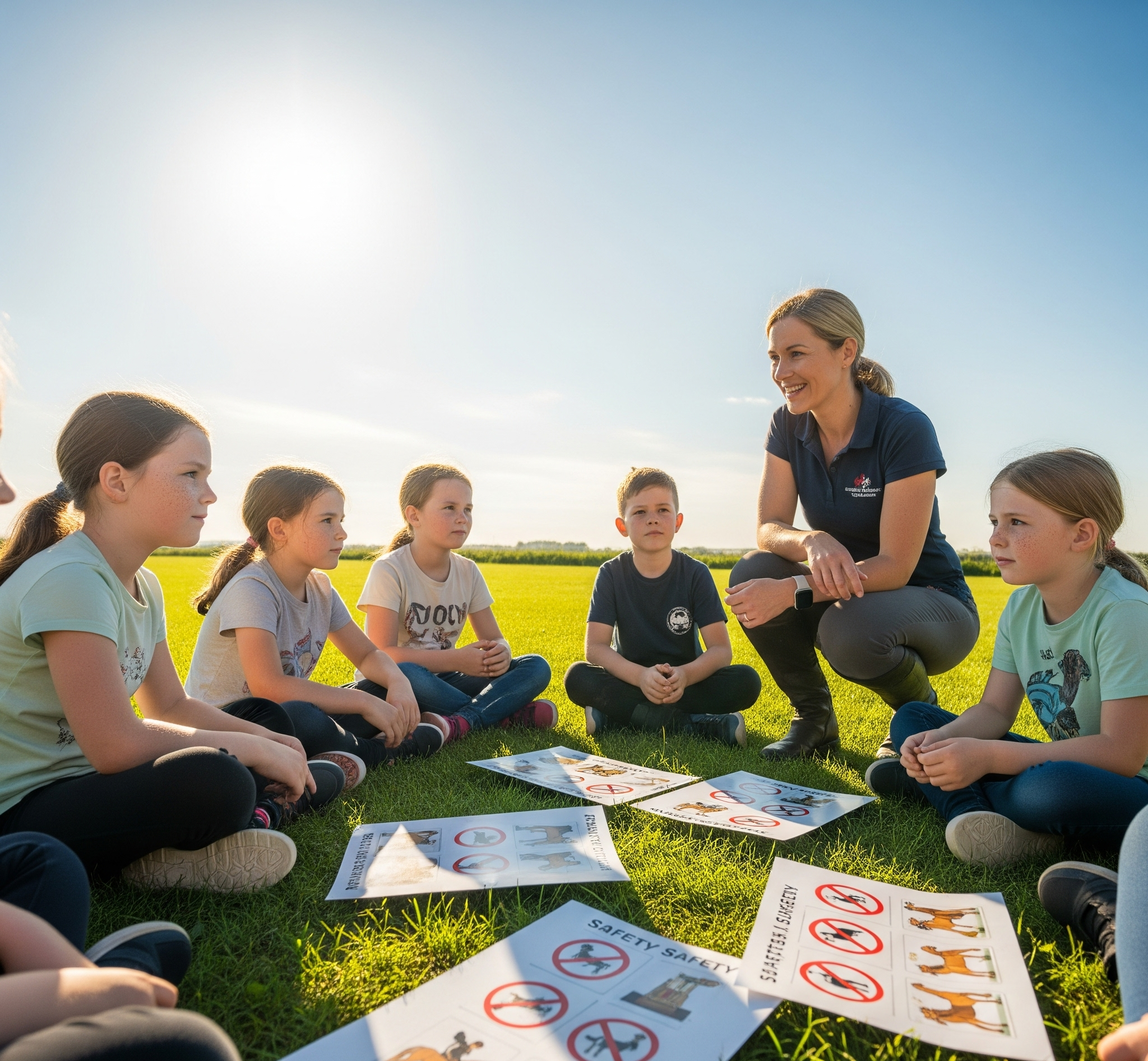
Interactive Safety Education: Teaching Horse Safety Through Drama and Role-Play
Transforming safety rule instruction into engaging, interactive activities creates memorable learning experiences that reinforce critical safety concepts. Drama-based safety education helps students internalize proper behaviors while building confidence and understanding through active participation rather than passive listening.
Activity 1: Safety Rule Game
Setup and Organization
Ideal Environment: Conduct activity in shaded area during hot weather or indoor space when outdoor activities aren't suitable for extended physical movement.
Group Assignment: Assign roles with one student acting as the horse and another as the handler/rider to demonstrate safety scenarios.
Instructor Participation: Join initial demonstrations to model enthusiasm and break the ice, encouraging reluctant participants to engage.
Participation Options: Allow voluntary participation while ensuring all students have opportunities to act when comfortable.
Execution Method
Real-Time Acting: Read safety rules aloud and have students immediately act out the scenarios as described.
Demonstration Focus: Students act out both incorrect behaviors (what not to do) and correct safety practices for comparison.
Interactive Learning: Encourage students to think about why certain behaviors are dangerous while physically demonstrating the concepts.
Educational Benefits
- Kinesthetic Learning: Physical movement reinforces verbal instruction for hands-on learners
- Memory Enhancement: Acting out scenarios creates stronger memory connections than passive instruction
- Problem Recognition: Students learn to identify unsafe situations through observation and participation
- Peer Learning: Group activities allow students to learn from watching others' demonstrations
Activity 2: Safety Charades Game
Game Setup
Materials Needed: Pre-written safety rule cards for consistent, organized gameplay
Team Selection: Choose one or two students to act out safety rules while others observe and guess
Guessing Format: Remaining students work together to identify which safety rule is being demonstrated
Rotation System: Ensure all participants get opportunities to both act and guess throughout the activity
Game Mechanics
Silent Demonstration: Acting students must convey safety concepts without speaking, building creative communication skills
Group Participation: All non-acting students can contribute to guessing process, maintaining engagement for entire group
Educational Discussion: After each correct guess, briefly discuss why the safety rule is important and how it prevents accidents
Essential Safety Rules for Role-Play Activities
Barn and Ground Behavior
Movement Guidelines:
- No Running: Demonstrate calm, controlled movement around horses and in barn areas
- Noise Control: Show appropriate voice levels that don't startle horses
- Approach Protocols: Practice proper methods for approaching and greeting horses safely
Personal Safety Practices:
- Appropriate Footwear: Demonstrate difference between safe boots and inappropriate footwear choices
- Jewelry Restrictions: Show how jewelry can create entanglement hazards around horses
- Protective Equipment: Practice proper helmet fitting and use
Horse Handling Techniques
Positioning and Movement:
- Safe Approach: Demonstrate approaching from front versus dangerous rear approaches
- Proper Leading: Show correct position beside horse versus unsafe positions
- Working Distance: Practice staying close to horse's body when working around hindquarters
Equipment Safety:
- Halter Fitting: Demonstrate proper halter adjustment and problems with loose equipment
- Lead Rope Management: Show safe handling versus dangerous wrapping around hands or body
- Quick-Release Knots: Practice safe tying techniques and emergency release methods
Riding Safety Protocols
Equipment Preparation:
- Stirrup Management: Demonstrate running up stirrups when dismounted for safety
- Proper Attire: Show appropriate riding boots with heels versus unsafe footwear
- Helmet Use: Practice correct helmet fitting and fastening procedures
Riding Practices:
- Mounting Safety: Demonstrate safe mounting and dismounting procedures
- Equipment Checks: Show pre-ride safety inspections of tack and equipment
- Emergency Procedures: Practice safe dismounting and emergency response techniques
Implementation Guidelines
Age-Appropriate Adaptations
Young Children (Ages 5-8):
- Focus on basic safety concepts with simple, clear demonstrations
- Use exaggerated movements to make safety concepts obvious and memorable
- Emphasize fun while maintaining educational value
Older Children/Teens (Ages 9-16):
- Include more complex safety scenarios and problem-solving elements
- Encourage detailed explanations of why certain behaviors are unsafe
- Challenge students to identify potential safety issues independently
Adult Learners:
- Focus on practical applications and real-world scenarios
- Encourage discussion of personal experiences and safety observations
- Emphasize professional responsibility and safety leadership
Safety During Activities
Physical Safety: Ensure adequate space for safe movement during demonstrations without creating actual hazards
Emotional Safety: Create supportive environment where all students feel comfortable participating without fear of ridicule
Educational Focus: Maintain emphasis on learning objectives rather than performance quality to reduce anxiety
Assessment and Learning Reinforcement
Knowledge Verification
Immediate Feedback: Provide corrections and explanations during demonstrations to reinforce proper understanding
Group Discussion: Encourage students to explain why demonstrated behaviors are safe or unsafe
Real-World Application: Connect demonstrated safety concepts to actual barn and riding situations students will encounter
Follow-Up Activities
Safety Observations: Encourage students to identify safety practices during regular barn and riding activities
Peer Teaching: Have experienced students help teach safety concepts to newcomers through demonstration
Regular Review: Incorporate safety demonstrations into regular lesson plans to maintain awareness and reinforce learning
Benefits for Comprehensive Safety Education
Enhanced Retention
Multi-Sensory Learning: Combining visual, auditory, and kinesthetic elements strengthens memory formation and recall
Emotional Engagement: Fun, interactive activities create positive associations with safety learning
Peer Reinforcement: Students learn from each other while building collaborative safety awareness
Practical Application
Behavior Modeling: Physical demonstration helps students understand exactly what safe behavior looks like in practice
Problem Recognition: Students develop ability to identify unsafe situations through repeated exposure to various scenarios
Confidence Building: Interactive learning builds confidence in applying safety knowledge in real situations
Interactive safety education through drama and role-play creates engaging learning experiences that transform potentially dry safety instruction into memorable, meaningful activities. By actively participating in safety demonstrations, students develop deeper understanding and stronger retention of critical safety concepts that protect both horses and handlers throughout their equestrian journeys.

Want More Lesson Plans?
RIDING INSTRUCTORS: Get instant access to the world's largest library of lesson plans! 1,000+ customizable exercises for every skill level, discipline, and teaching situation. Never run out of ideas again.
Join thousands of instructors who've transformed their teaching →
